
Ciao a tutti! For October, I would like to share details of my recent visit to the ancestral hometown of my Occhipinti family, which is called Ragusa, and is located high in the mountains of the southeastern tip of Sicily.
If you’ve been following my activities through my Instagram posts on Conversationalitalian.french, or through my Facebook group, Conversational Italian! you know that I was thrilled to spend 7 full days in Ragusa just last month.
About once a month, I have been re-blogging a post about lesser-known sites or places to visit in Italy under the title “Your Italian Travel Tips.” I’ve been featuring travel bloggers in this series, but this month I will use this feature to show a bit of what I’ve just experienced in Ragusa in “travel blogger style,” with my own emphasis on language and history.
And remember Conversational Italian for Travelers: Just the Important Phrases on Amazon.com and Learn Travel Italian.com if you need a compact, lightweight pocket guidebook to take on your next trip! Free Cultural Notes, Italian Recipes, and Audio to help you practice your Italian are also found on Learn Travel Italian.com.
Learning Italian
with
Commissario Montalbano
Before starting our virtual blogging tour of Ragusa, it should be mentioned that, due to the popularity of the BBC series Detective Montalbano (Commissario Montalbano), based on the detective novels of the brilliant Andrea Camilleri, who the world lost this past July 17, 2019,
the ancient Baroque towns of Ragusa and nearby Scicli and Modica, along with many places along the coast of Southern Sicily, have come into the forefront once again.
Yes, it is true. I am a HUGE fan of the Detective Montalbano series! Over the years, this BBC series has helped me to gain an understanding of how people really use common Italian expressions (most of which, of course are not found in textbooks, and which I try to focus on in my own books and blogs).
Anyone who has attended even one of my Italian lessons has heard my recommendation for using the Detective Montalbano series as an aid to learning Italian. Listen to the characters as they interact, pick out the phrases you understand and focus on how these phrases are used. Some characters will be easier to understand than others, just like people in real life. One caveat—don’t try to understand the character Catarella, who speaks his own version of Sicilian/Italian that even the other characters often mention they do not understand!
Actually, it is amazing that I waited until this late in the blog to mention that I visited many of the locations where the Detective Montalbano series is filmed!
If anyone else is a fan of the Detective Montalbano series, you should know that the entire set of the Montelusa police station is now on permanent exhibition in the city of Scicli and that the Montalbano character’s villa at Punta Secca is now a tourist attraction, along with the restaurant Enzo da Mare a little further down on the beach. There are even “Detective Montalbano” tours on the internet. If you’d like to create your own tour, simply download the sites of interest from the Ragusa Turismo Site on the internet.
You will need a car to visit the sites outside of Ragusa, though, as the train is not very efficient in Sicily (or so I am told).
Particulars of Visiting Ragusa
Transportation (or lack of it) to your hotel:
Ragusa Ibla, or the historic, older section of Ragusa, is an ancient city, carved into the side of a mountain, with narrow, winding cobblestone streets that are interconnected by many steep and just as winding stairways. As such, most of the city is protected by a limited traffic zone. Tour buses and city buses, along with a train station, are located in lots at the base of this mountain city. So, practically speaking, the first thing to do once you have booked your hotel is to contact the hotel before you arrive (either over the phone or through the Internet), the best way to get from those lots to the hotel front door! Many hotels will send a porter to help with luggage, and many drivers know also that it will be necessary for them to get out of the car and to walk with luggage to get their guests to their hotel door. It is always better to arrange this beforehand to eliminate confusion and any hidden fees.
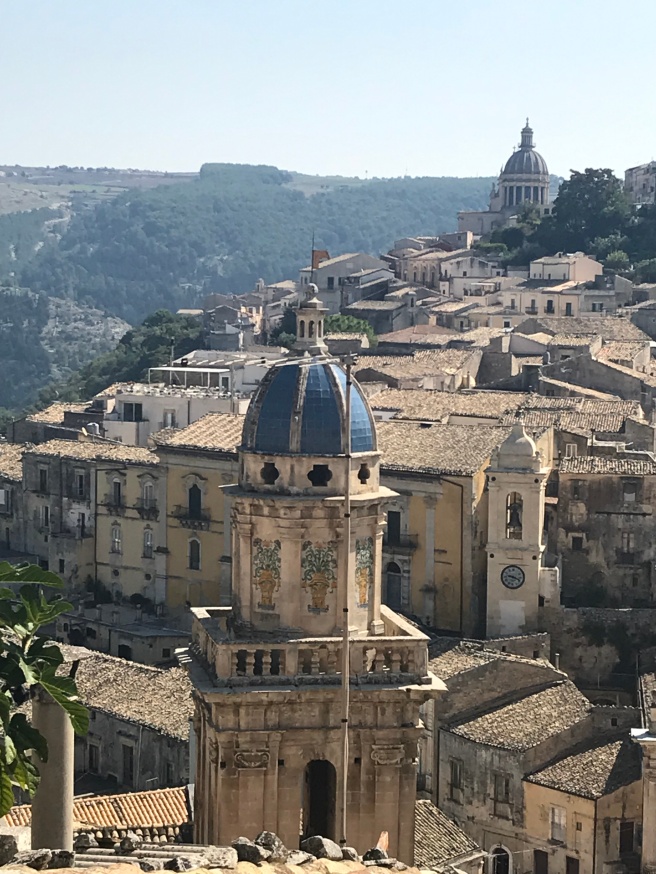
*************************************
Where I’ve stayed:
Given the size and age of Ragusa Ibla, it should be noted that accommodations are provided mainly through bed and breakfast style hotels.
The exception is the San Giorgio Hotel, which is literally built into the side of the southern part of the mountainside of Ragusa Ibla. I did stay at this hotel in 2016, and found the staff so pleasant and accommodating (the concierge actually took it upon himself to help me find the location of my great grandfather’s home) that I would recommend this hotel for those who want a more formal stay. Some of the rooms do not have windows, though, given the location, so I would ask about this if it is a concern. Otherwise, the hotel furnishing were modern, the hotel itself was clean, breakfast was lovely, and as I’ve mentioned the staff were wonderful, and even overly concerned that I enjoy my stay, some even mentioning their cousins with the Occhipinti name.
I have to admit that I chose the bed and breakfast I stayed at just recently for my 7 day trip based mostly on photos of the breakfast selection I found on the internet! After several evenings of searching, I came upon the breakfast room of the lovely Hotel Sabbinirica, and chose to stay in the guesthouse around the back of the main hotel. The guest house was spacious and clean, with a small courtyard, although it did not offer a view of the city. And the breakfast did not disappoint! Every day the owners were on sight to make fresh espresso drinks to order and the breakfast table was laden with fruit, many varieties of Sicilian pastries (with new ones to try each day), Sicilian cheeses, yogurt, hard boiled eggs, toast and cold cuts. Juices, as usual throughout Italy, were freshly squeezed. And the breakfast room was charming, a mixture of the old and new, built into the side of the mountain.

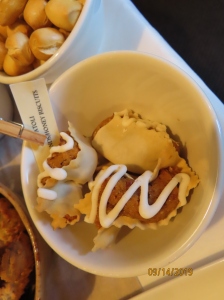
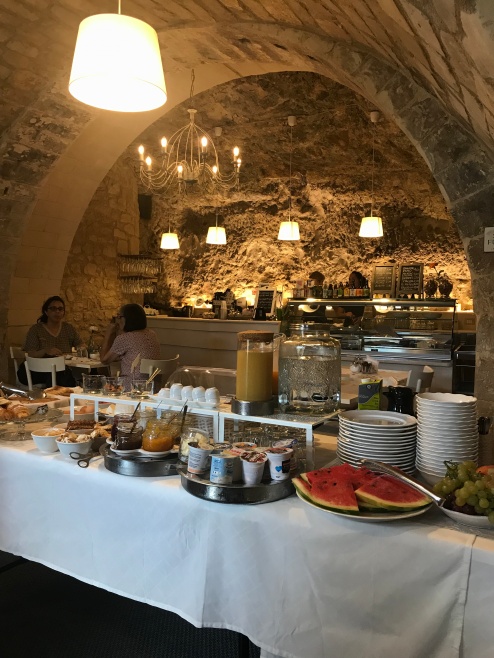
The owners came to pick us up from the parking at the foot of the mountain in a motorized golf cart and drove us to the entrance of the bed and breakfast, showed us our room, and very kindly gave us directions on how to reach the main piazza (which was not far away) with the restaurants for dinner. At the reception were pamphlets that held suggestions for tours, both group and private and notice of a bus schedule to the surrounding town. To the side of the reception area was a small boutique filled with handcrafted Sicilian pottery and embroidery.
After our check-in, it was a long walk up the stairs each evening to reach the Hotel Sabbinirica from the taxi station at the Piazza Repubblica, or an even longer climb from the parking lot below. But, once reached, the hotel is on the same level as the lively main piazza that is lined with most of the shops and restaurants in town and hosts the largest church, San Giorgio at its far end. In the morning and evening, the hotel entrance boasted spectacular views of Ragusa Superior, and I have to say that I thoroughly enjoyed my stay at this hotel.
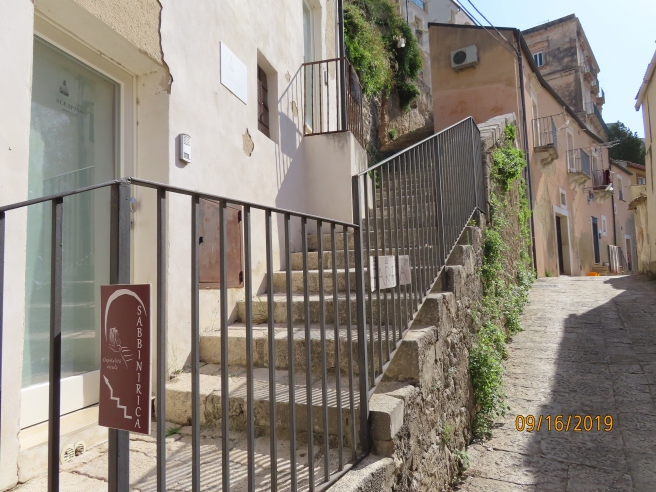
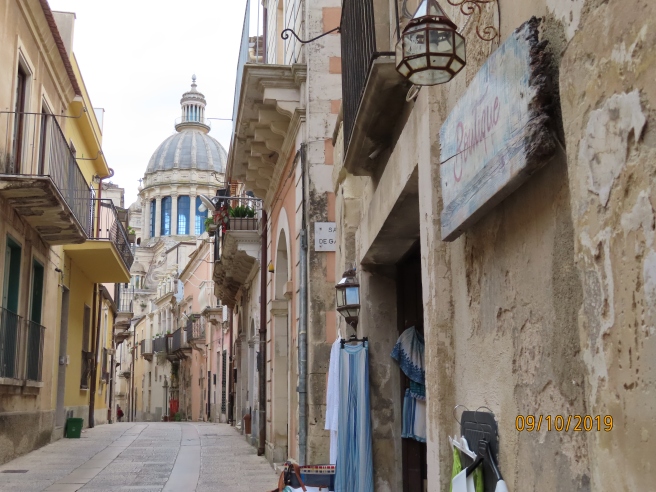
There are many charming bed and breakfasts in Ragusa Ibla. If you have a favorite, please share your experience!
Where to eat for a special night:
There are many restaurants in Ragusa that offer local specialties, from pizza to formal dining with all courses (antipasto, primo of pasta, secondo of fish or meat, and dolce). When traveling, I usually choose the restaurant where I have dinner on the spur of the moment, based on the location I end up at after I finish exploring for the day (side street not main piazza), the menu (no pictures, local specialties) and the clientele (locals).
While I was not in Ragusa every evening, so I cannot give an exhaustive list of restaurant recommendations, I did dine at MareDentro twice for dinner, and loved their fresh seafood and preparation of traditional Sicilian dishes.
I also had one special dinner with my traveling companion at the Duomo restaurant of Chef Ciccio Sultano. The webiste Great Italian Chefs says: “One of Sicily’s best-loved chefs, Ciccio Sultano has traveled as far as New York to hone his craft. Now back home, Ciccio’s two-Michelin-starred restaurant Duomo is the standard bearer for Sicilian haute cuisine, attracting diners from far and wide to the city of Ragusa.”
My experience truly lived up to the hype. Despite the fact that we had only ordered a primo and secondo course, we were offered so many “special” treats that the chef “would be so pleased for us to try” that I was truly dazzled. Not only by the number of offerings abut also by the style of the chef. I don’t usually take photos of the food while I am out dining, so I guess we will just have to go with this description of my meal from the Great Italian Chefs website:” It only takes a cursory glance at Ciccio’s food to see that these dishes are unmistakably his. His playful, artistic flair is always on display, and his plates are a unique combination of his avant garde character and his love and respect for the food of his home.”
Then I found this description of the restaurants in Ragusa from The Thinking Traveler:
“The restaurant “Duomo”, in Via Capitano Bocchierei, 31, is double Michelin-starred and considered one of the very best restaurants in Italy, while La Locanda di Don Serafino and La Fenice both have 1 Michelin Star… Is Ragusa the gourmet capital of Sicily?”
Oh, and by the way… gelato:
This is an easy one. Both gelato shops on the main piazza in Ragusa were fantastic, with unusual flavors I have not seen in other parts of Italy.

Short Historical Tour of Ragusa
Before the city of Ragusa was called Ragusa, it was founded by the indigenous people of Sicily and known in the world of ancient Greece as Hybla Heraea. The Greeks colonized much of southeastern Sicily and flourished, especially in Agrigento along the southern coast and Siracusa along the eastern coast. Southern Sicily in antiquity was considered a center of learning, with Archimedes (the philosopher and mathematician who discovered that 3.14… is pie), one of its most brilliant minds. Ragusa, however, remained independent from the Greeks, only to be overtaken by the Romans in the middle of the third century B.C. After this conquest, the city fell under the rule of many different peoples, but was finally given the name “Ragus” when under Arab rule. After the Norman conquest in 1060, the name was changed to Ragusa, which the city has carried to this day. In 1860, Garibaldi added Ragusa to the newly united Kindgom of Italy.
Here is a short synopsis of how the Ragusa the visitor sees today came to be from The thinking Travaeler:
“Essentially Baroque, the Ragusa you will see today dates almost entirely from 1693. Indeed, it was in this year that Ragusa, along with its neighbours, Noto, Modica, Scicli and Catania, was razed to the ground by a terrible earthquake that hit most of the eastern side of Sicily.”
“Public opinion on where to rebuild the town was divided, and so a compromise was made. The wealthier, more aristocratic citizens built a new town in a different site, now Ragusa “Superiore”, while the other half of the population decided to rebuild on the original site, on a ridge at the bottom of a gorge, now Ragusa Ibla. The two towns remained separated until 1926 when they were merged to become the chief town of the province, taking the place of Modica.”
The town Ragusa Ibla is part of the Val di Noto UNESCO Heritage site and 18 of its buildings are protected by UNESCO patronage.
Short Walking Tour of Ragusa
A visit to the Commune Ragusa website yields a list of churches and buildings for a UNESCO walking tour of Ragusa, and in particular a tour of Baroque architecture, or the Barocco tour. There is a trolley that will take you on a tour as well, circling around the outer perimeter of the mountain to reach many of these sites.
Baroque architecture is said to have originated in Italy in Rome in the early 17th Century, and then to have spread into other parts of the Italian peninsula and Europe. By the mid-17th century, this highly decorative style was used to create churches with frescoes covering every inch of their walls and ceilings, which were held up by colorful, spiraled columns. The exteriors of government buildings and private homes were decorated with ornate, heavy balconies supported by heavy, statuesque corbels and framed by undulating ironwork to show wealth and power.
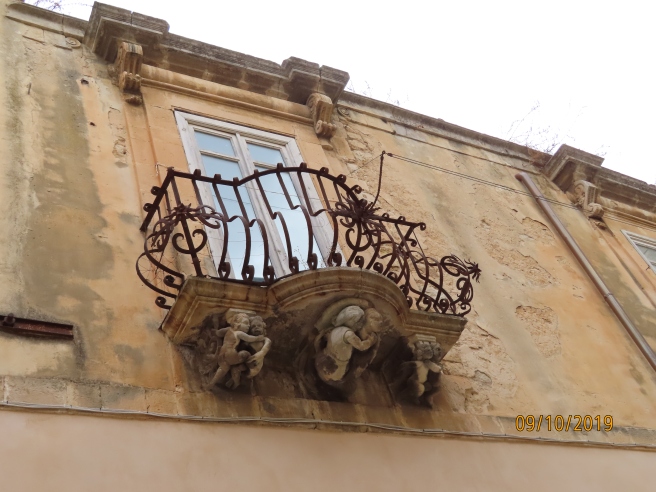
Ragusa is just one town in a group of nine towns of medieval origin located in the Val di Noto, or southeastern Sicily that were rebuilt in splendor in the new Baroque style after the earthquake of 1693 devastated this region. The other towns are: Caltagirone, Militello, Catania, Modica, Noto, Palazzolo, Ispica and Scicli.
On the first day of our stay in Ragusa, we visited the cathedral of San Giorgio and the Later, we decided to follow the large, brown street signs from our hotel on the border of Ragusa Ibla to Ragusa Superiore. Below are some images from our tours of Ragusa to enjoy.
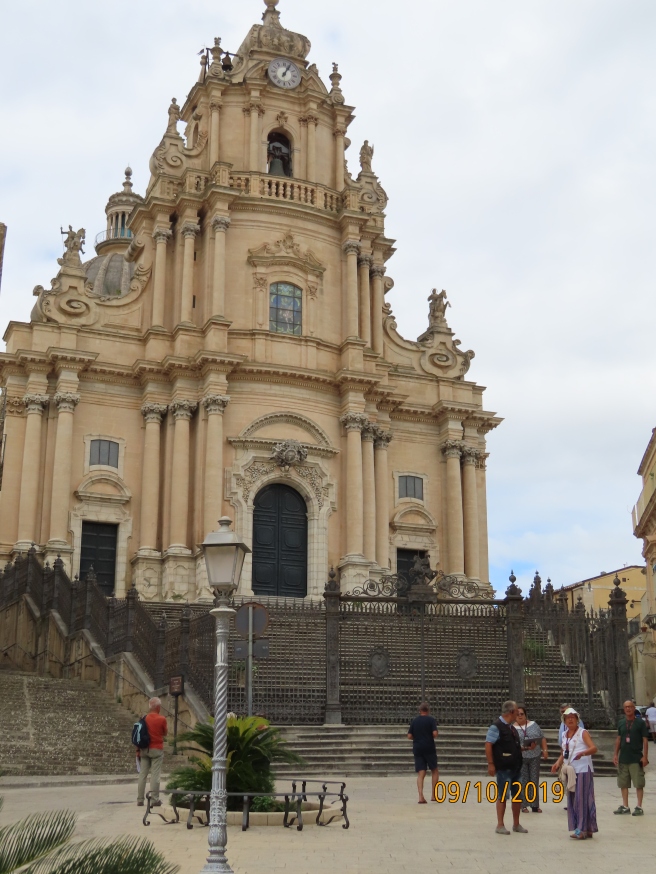
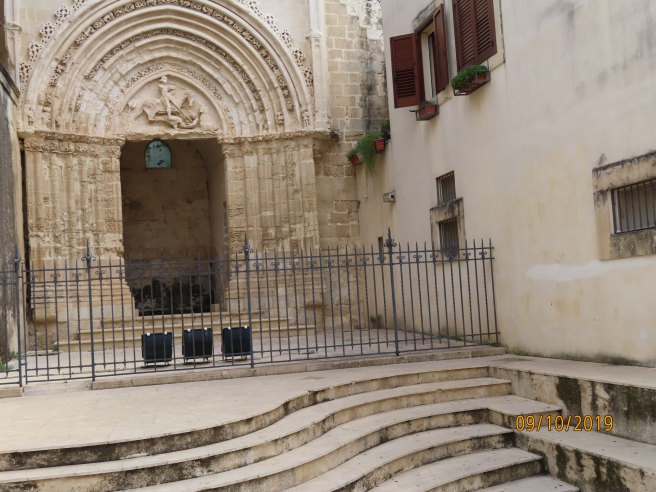
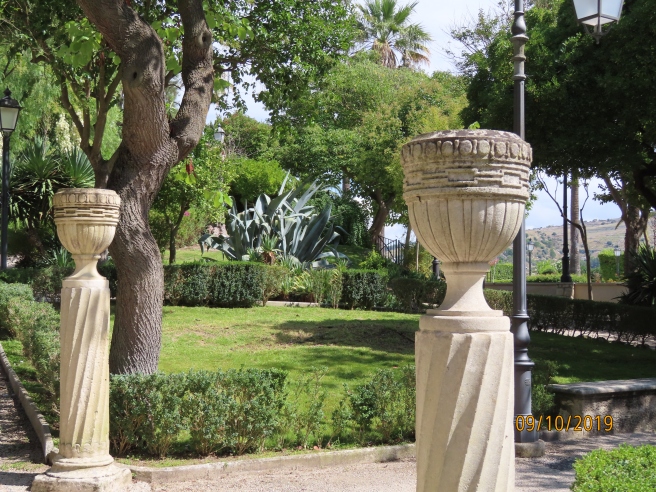
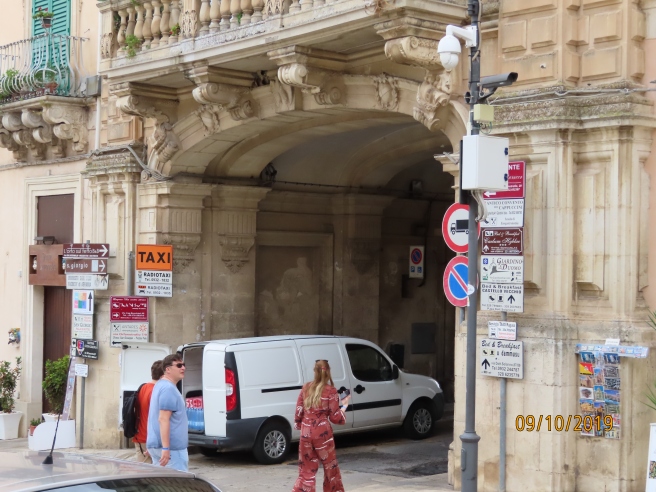
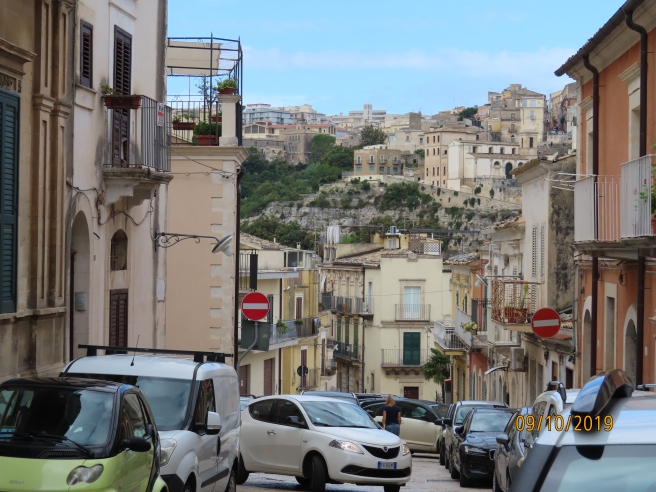
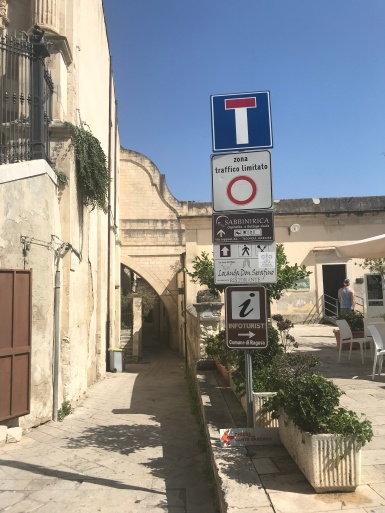
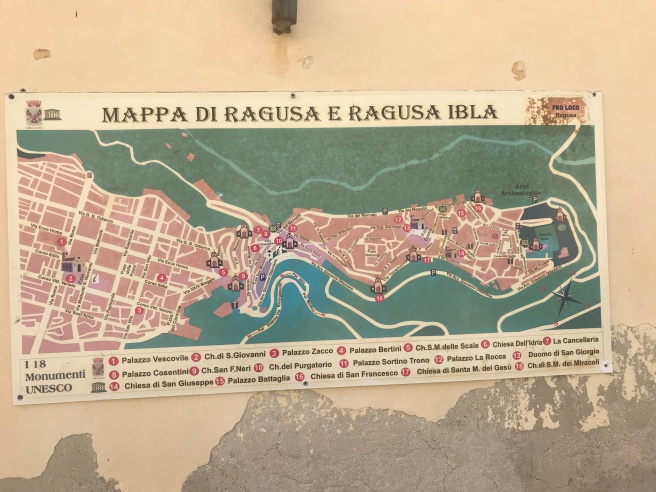

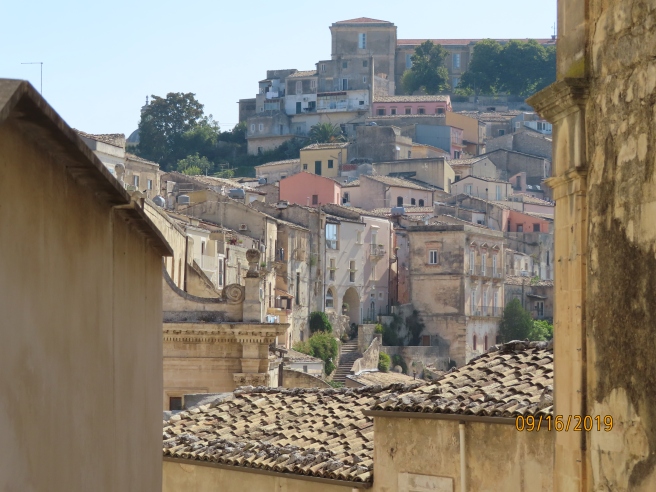
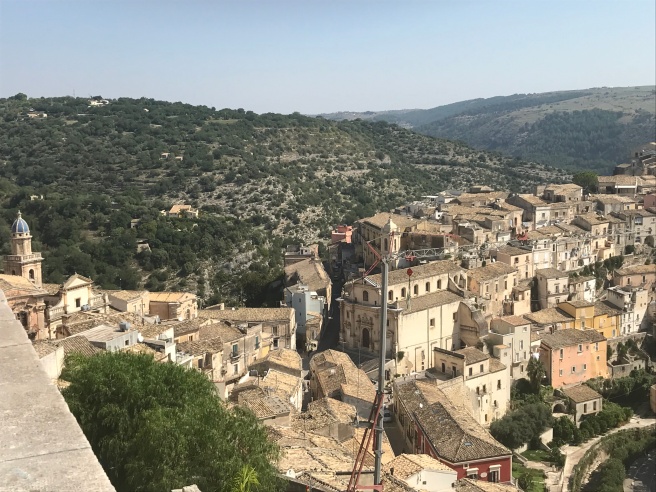
Sites of Interest
in and around
Ragusa
Church of Santa Maria delle Scale: location offers spectacular views of Ragusa Ibla. and is the oldest church in Ragusa. Occasional site of filming to use Ragusa Ibla as the backdrop for scenes in the Detective Montalbano series.
Palazzo Casentini—late 1700’s Baroque style
Palazzo Bertini—late 1700’s Baroque style
Church of San Giuseppe—Baroque church that houses many Baroque works of art; San Giuseppe is the patron saint of Ragusa, while San Giorgio is the patron saint of Ragusa Iba
Hyblean Archeological Museum—along the outskirts of Ragusa. Can’t believe I missed it this time around!
Shopping in Ragusa Superiore—My favorite shop for women’s fashion, Louisa Spagnoli is in Ragusa Superiore along the main shopping boulevard. More casual styles than the Louisa Spagnoli shop by Piazza del Popolo in Rome.
Castello di Donnafugata (means “source of health” in Arabic; when translated into Sicililan sounds similar to the Italian “donnafugata”, but does not mean “the woman who fled”)—large estate with villa with origins in the 14th century, but current style in each room preserved as a museum is from the 19th century. Occasional site of filming for Detective Montalbano series.
Marina di Ragusa—Loved walking on the boardwalk along the beach at Marina di Ragusa one evening. This is where the Italians vacation with their families and after dinner is the time to “fare una passegiatta” (take a leisurely stroll). If you like people watching, this is the place, as everyone is dressed in the latest summer styles to “fare una buona figura” (make a good appearance). There is a large boulevard along the boardwalk and across the street are many apartments for rent for a week or more, a few hotels, and many restaurants large and small catering to Italian tourists. Maybe for my next trip?



Thank you for your lovely post. I am hopeful that Sicily will continue to see its Covid numbers decline and its vaccination rates go up, and that it will soon be opening up to locals as well as vaccinated tourists. In that hopeful spirit, I am starting to plan a solo (!!) trip to Sicily for September, which will include 3 nights in Ragusa. Your post has whet my appetite! Thank you.
LikeLike
So glad you enjoyed my post about Ragusa. I truly had a wonderful experience when I visited and I hope you do as well!
LikeLike
Wow, sounds like a wonderful week! I visited Ragusa just for a day many years ago and I remember all the stairs up from the parking, but what a beautiful town in a dramatic setting. I love the Montalbano series. The opening credits, particularly of the older episodes despite the rawness of the theme music’s execution, gives such a beautiful view of Ragusa. On the one hand, I’d like to follow in Montalbano’s footsteps visiting the film locations, but on the other hand, I think I’d be disappointed not to see Montalbano coming out of the sea after his morning swim.
LikeLike
Thanks for your comments, Karen. Definitely lots to see and do in Ragusa if you return (and I hope you do). And about Montalbano: I agree! It was a bit disappointing not to have him unlock the gate to his villa and welcome me in. But still so interesting to actually be in a place that I feel like I know so well!
LikeLiked by 1 person
Wonderful post! Our experience last year was similar. So fun for Montalbano followers!! Reading your post made me relive our trip.
LikeLike
Thanks for your comments, especially as a fellow Montalbano follower!
LikeLike